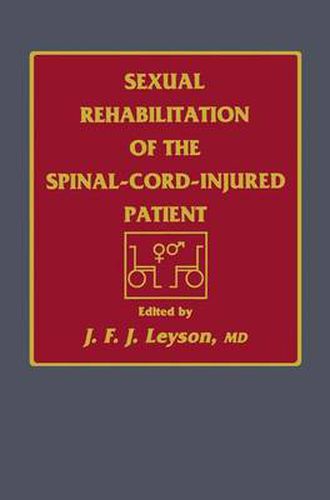Readings Newsletter
Become a Readings Member to make your shopping experience even easier.
Sign in or sign up for free!
You’re not far away from qualifying for FREE standard shipping within Australia
You’ve qualified for FREE standard shipping within Australia
The cart is loading…






This title is printed to order. This book may have been self-published. If so, we cannot guarantee the quality of the content. In the main most books will have gone through the editing process however some may not. We therefore suggest that you be aware of this before ordering this book. If in doubt check either the author or publisher’s details as we are unable to accept any returns unless they are faulty. Please contact us if you have any questions.
G. Blasius ftrSt described the anatomic aspects of spinal cord injury (SCI) in 1666. Until thattime, society had totally ignored the physically disabled, let alone allowed them to mingle socially and sexually. ThemilitaIymortalityratebetween 1814-1914wasestimatedto be50-80%,although sexualandsocioculturalimplicationswere not addressed. Ina1928novel, Lady Chatterley’s Lover, D.H.Lawrence stronglyreflected the sexual concernsofa paraplegic who had been labeled impotent The modern managementofSCI was initiated by Monroe and Guttman in 1943, but with heavy emphasis on physical and urological rehabilitation and only supetficial attention to sexual dysfunctions. H. W. Home et al. started the investigation of SCI infertilityproblems in1950. Itwasnotuntil1960thatBorsandComarr collaboratedonastudythatclassifiedthetypesofsexualdysfunctions inrelation toneurologicallevelsoflesionsfollowing spinalcooltrauma. Nonnal (nondisabled)sexualitycameofageduring thepasttwo decades.Thiswashighlightedbythe 1966publicationofW.Masters’, HumanSexualResponse. However,thetopicofsexualityinphysically challenged(handicapped)personsremainslargelytabooinourpresent society. Thereareanestimated10-12millionSCIpersonsworldwide. InAmerica,thereareapproximately1.2-1.5millionSCIvictims,with an annual incidenceof12,000-15,000,oroneevery 35minutes. The visibility of SCI persons was enhanced when the United Nations declared 1980-1990as thedecadeofdisabledpersons. Furthennore, theenactmentintolaw,inJuly, 1990,ofthe AmericanDisabilities Act, pointed out the handicapped person’s right to the fullest pursuit of happiness. Since the release in 1974of K. Heslinga’s Not Made of v vi Preface Stone, only a handful ofbooks on medical sexuality for the disabled have been published. This book has three majorobjectives: 1. toprovidethoroughandcomprehensivecoverageofdisabled persons’ sexuality in all sexual orientations; 2. to introduce new tenninologies and theories, to redefine certainsexualdysfunctions,and todescribeupdatedtreatment formats; and 3. topresentresearchandinnovationsthatmaystimulatefurther investigationsintodisabled sexualityduring the nextdecade. The first partofthis bookdefines new sexual terminology and describes the full spectrumofsa sexual challenges. Thesecondhalfofthebookdealswithavarietyofdiagnosticand therapeutic sexual innovations, AIDS implications, and cosmic sex- ology. Finally, the Appendix lists international sexual referral centers and informationorganizations.
$9.00 standard shipping within Australia
FREE standard shipping within Australia for orders over $100.00
Express & International shipping calculated at checkout
This title is printed to order. This book may have been self-published. If so, we cannot guarantee the quality of the content. In the main most books will have gone through the editing process however some may not. We therefore suggest that you be aware of this before ordering this book. If in doubt check either the author or publisher’s details as we are unable to accept any returns unless they are faulty. Please contact us if you have any questions.
G. Blasius ftrSt described the anatomic aspects of spinal cord injury (SCI) in 1666. Until thattime, society had totally ignored the physically disabled, let alone allowed them to mingle socially and sexually. ThemilitaIymortalityratebetween 1814-1914wasestimatedto be50-80%,although sexualandsocioculturalimplicationswere not addressed. Ina1928novel, Lady Chatterley’s Lover, D.H.Lawrence stronglyreflected the sexual concernsofa paraplegic who had been labeled impotent The modern managementofSCI was initiated by Monroe and Guttman in 1943, but with heavy emphasis on physical and urological rehabilitation and only supetficial attention to sexual dysfunctions. H. W. Home et al. started the investigation of SCI infertilityproblems in1950. Itwasnotuntil1960thatBorsandComarr collaboratedonastudythatclassifiedthetypesofsexualdysfunctions inrelation toneurologicallevelsoflesionsfollowing spinalcooltrauma. Nonnal (nondisabled)sexualitycameofageduring thepasttwo decades.Thiswashighlightedbythe 1966publicationofW.Masters’, HumanSexualResponse. However,thetopicofsexualityinphysically challenged(handicapped)personsremainslargelytabooinourpresent society. Thereareanestimated10-12millionSCIpersonsworldwide. InAmerica,thereareapproximately1.2-1.5millionSCIvictims,with an annual incidenceof12,000-15,000,oroneevery 35minutes. The visibility of SCI persons was enhanced when the United Nations declared 1980-1990as thedecadeofdisabledpersons. Furthennore, theenactmentintolaw,inJuly, 1990,ofthe AmericanDisabilities Act, pointed out the handicapped person’s right to the fullest pursuit of happiness. Since the release in 1974of K. Heslinga’s Not Made of v vi Preface Stone, only a handful ofbooks on medical sexuality for the disabled have been published. This book has three majorobjectives: 1. toprovidethoroughandcomprehensivecoverageofdisabled persons’ sexuality in all sexual orientations; 2. to introduce new tenninologies and theories, to redefine certainsexualdysfunctions,and todescribeupdatedtreatment formats; and 3. topresentresearchandinnovationsthatmaystimulatefurther investigationsintodisabled sexualityduring the nextdecade. The first partofthis bookdefines new sexual terminology and describes the full spectrumofsa sexual challenges. Thesecondhalfofthebookdealswithavarietyofdiagnosticand therapeutic sexual innovations, AIDS implications, and cosmic sex- ology. Finally, the Appendix lists international sexual referral centers and informationorganizations.